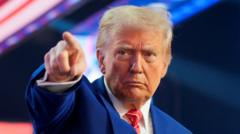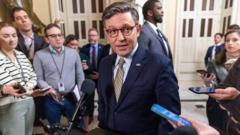As the U.S. finds itself in a political transition, both President Biden and President-elect Trump are shaping diplomatic landscapes, leaving foreign leaders grappling with dual visions for America's direction.
# Two Leaders, One Nation: The Dynamics of Power During Transition

# Two Leaders, One Nation: The Dynamics of Power During Transition
Former President Donald Trump sets the stage for a contentious transition, pursuing independent foreign policy initiatives as Biden achieves peace in the Middle East.
In a remarkable juxtaposition of leadership, the U.S. experiences a unique political dynamic as President Biden engages in international diplomacy while President-elect Trump orchestrates a stark shift in trade policy from his Florida estate.
While President Biden works toward a cease-fire between Israel and Hezbollah, Trump has declared an imminent trade war, planning to impose tariffs on key trading partners including Canada and Mexico alongside rival China on the inaugural day of his presidency. This unfolding scenario illustrates an unusual circumstance where foreign policy is being concurrently shaped by two presidents.
The transition period is often marked by a sense of continuity, but this instance has seen a pronounced shift, according to Suzanne Maloney of the Brookings Institution. With the incoming president vocalizing a competitive agenda, global leaders are struggling to navigate the duality of influence. This compelling backdrop of diplomacy is further complicated by Trump's inner circle’s rejection of traditional transition norms, leading to an uncertain future for international relations.
Foreign leaders may find themselves in a strategic bind, weighing the potential benefits of aligning with a more established Biden administration against the prospect of an unpredictable Trump agenda. As the U.S. grapples with these contrasting approaches, the world watches closely, seeking clarity amid the chaos of competing visions for America’s role on the global stage.
While President Biden works toward a cease-fire between Israel and Hezbollah, Trump has declared an imminent trade war, planning to impose tariffs on key trading partners including Canada and Mexico alongside rival China on the inaugural day of his presidency. This unfolding scenario illustrates an unusual circumstance where foreign policy is being concurrently shaped by two presidents.
The transition period is often marked by a sense of continuity, but this instance has seen a pronounced shift, according to Suzanne Maloney of the Brookings Institution. With the incoming president vocalizing a competitive agenda, global leaders are struggling to navigate the duality of influence. This compelling backdrop of diplomacy is further complicated by Trump's inner circle’s rejection of traditional transition norms, leading to an uncertain future for international relations.
Foreign leaders may find themselves in a strategic bind, weighing the potential benefits of aligning with a more established Biden administration against the prospect of an unpredictable Trump agenda. As the U.S. grapples with these contrasting approaches, the world watches closely, seeking clarity amid the chaos of competing visions for America’s role on the global stage.



















